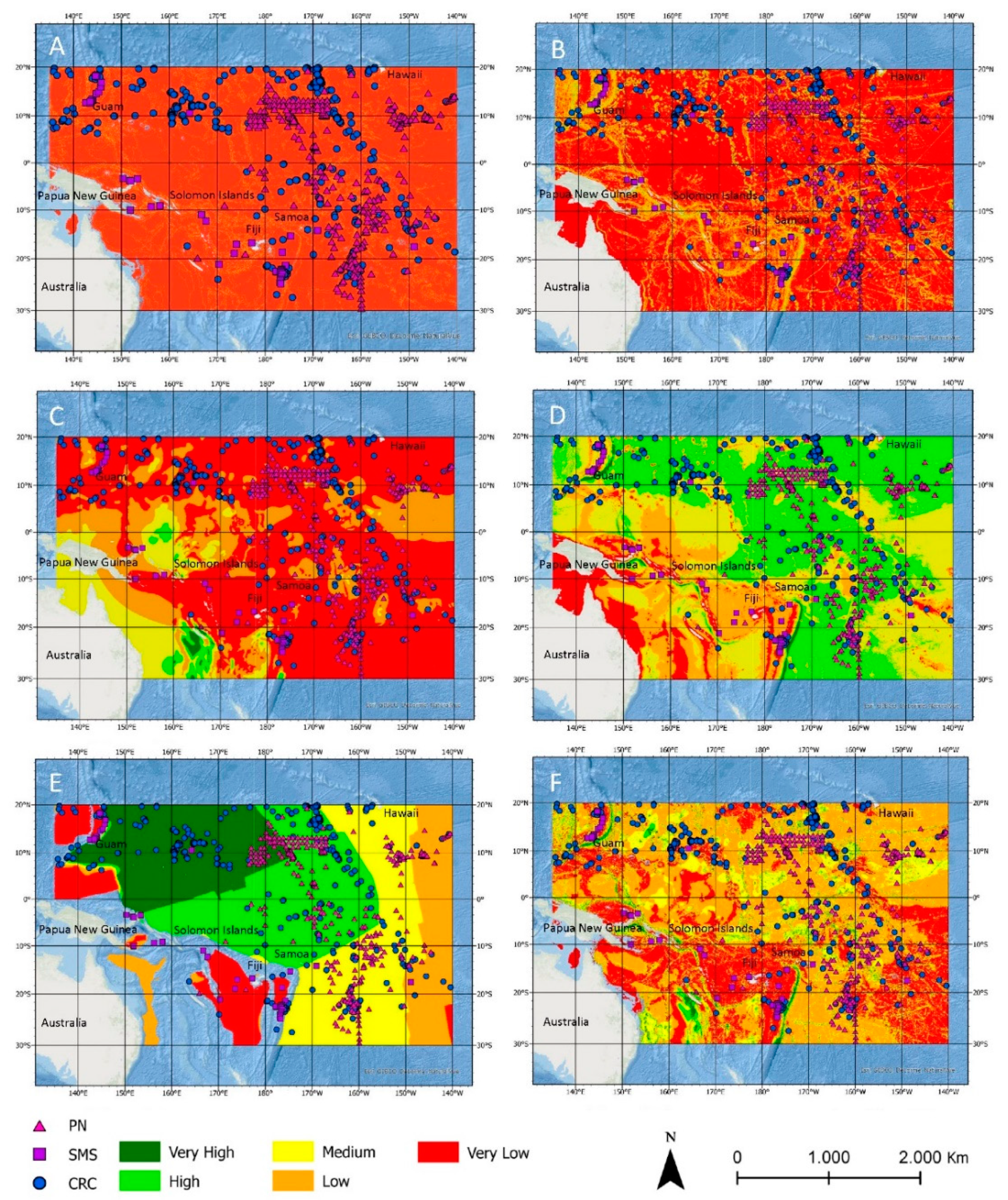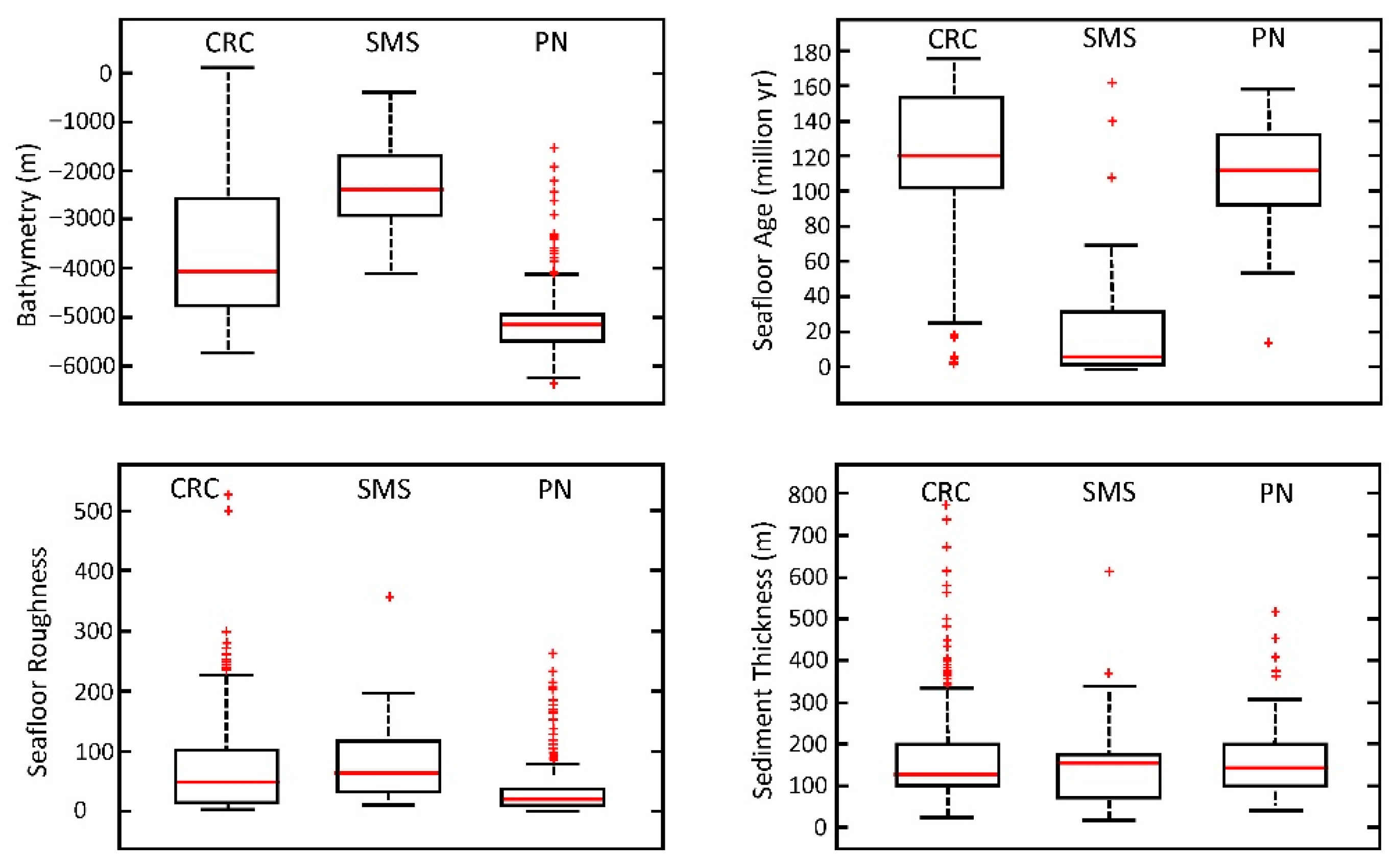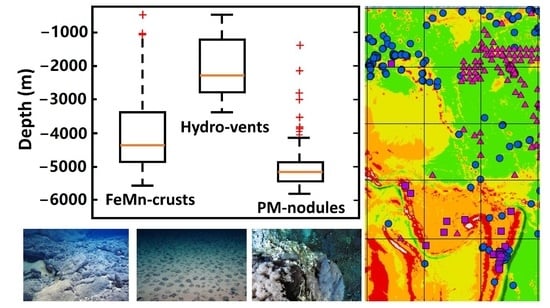Exploring Ocean Floor Geodiversity in Relation to Mineral Resources in the Southwest Pacific Ocean
Abstract
:1. Introduction
2. Materials and Methods
2.1. Input Data
2.2. Workflow for Ocean Floor Geodiversity
2.3. Statistics Analysis
3. Results
3.1. Index Maps
3.2. Statistical Analysis
4. Discussion
4.1. Geodiversity Definition and Index Development
4.2. Geodiversity and Distribution of Mineral Resources
4.3. Concluding Remarks
Author Contributions
Funding
Acknowledgments
Conflicts of Interest
References
- Gray, M. Geodiversity: Valuing and Conserving Abiotic Nature, 2nd ed.; Wiley-Blackwell: Chichester, UK, 2013; 495p. [Google Scholar]
- Van Ree, C.C.D.F.; van Beukering, P.J.H. Geosystem services: A concept in support of sustainable development. Ecosyst. Serv. 2016, 20, 30–36. [Google Scholar] [CrossRef]
- Ruban, D.A.; Yashalova, N.N. Geodiversty meanings in global geoparks: An empirical study. Environ. Earth Sci. 2018, 77, 771. [Google Scholar] [CrossRef]
- Wolniewicz, P. Beyond Geodiversity Sites: Exploring the Educational Potential of Widespread Geological Features (Rocks, Minerals and Fossils). Geoheritage 2021, 13, 34. [Google Scholar] [CrossRef]
- Bailey, J.J.; Boyd, D.S.; Hjort, J.; Lavers, C.P.; Field, R. Modelling native andalien vascular plant species richniess: At which scales is geodiversity most relevant? Global. Ecol. Biogeogr. 2017, 26, 763–776. [Google Scholar] [CrossRef] [Green Version]
- Hjort, J.; Heikkinen, K.; Luoto, M. Inclusion of explicit measures of geodiversity improve biodiversity models in a boreal landscape. Biodivers. Conserv. 2012, 21, 3487–3506. [Google Scholar] [CrossRef]
- Brilha, J.; Gray, M.; Pereira, D.I.; Pereira, P. Geodiversity: An integrative review as a contribution to the sustainable management of the whole of nature. Environ. Sci. Policy 2018, 86, 19–28. [Google Scholar] [CrossRef] [Green Version]
- Gordon, J.E.; Crofts, R.; Diaz-Martinez, E.; Woo, K.S. Enhancing the Role of Geoconservation in Protected Area management and Nature Conservation. Geoheritage 2018, 10, 191–203. [Google Scholar] [CrossRef] [Green Version]
- Schrodt, F.; Bailey, J.J.; Kissling, W.D.; Rijsdijk, K.F.; Seijmonsbergen, A.C.; van Ree, D.; Hjort, J.; Lawley, R.S.; Williams, C.N.; Anderson, M.G.; et al. Opinion: To advance sustainable stewardship, we must document not only biodiversity but geodiversity. Proc. Natl. Acad. Sci. USA 2019, 116, 16155–16158. [Google Scholar] [CrossRef] [Green Version]
- Coratza, P.; Vandelli, V.; Fiorentini, L.; Paliaga, G.; Faccini, F. Bridging Terrestrial and Marine Geoheritage: Assessing Geosites in Portofino Natural Park (Italy). Water 2019, 11, 2112. [Google Scholar] [CrossRef] [Green Version]
- Kaskela, A.M.; Rousi, H.; Ronkainen, M.; Orlova, M.; Babin, A.; Gogoberidze, G.; Kostamo, K.; Kotilainen, A.T.; Neevin, I.; Ryabchuk, D.; et al. Linkages between benthic assemblages and physical environmental factors: The role of geodiversity in Eastern Gulf of Finland ecosystems. Cont. Shelf Res. 2017, 142, 1–13. [Google Scholar] [CrossRef]
- Zelewska, I.; Najwer, A.; Zwoliński, Z. Geodiversity evaluation of the Słupsk Bank boulder area. Bull. Marit. Inst. Gdańsk 2018, 33, 178–188. [Google Scholar]
- Fouquet, Y.; Cambon, P.; Etoubleau, J.; Charlou, J.L.; Ondreas, H.; Barriga, F.J.A.S.; Cherkashov, G.; Semkova, T.; Poroshina, I.; Bohn, M.; et al. Geodiversity of hydrothermal processes along the Mid-Atlantic Ridge and ultramafic hosted mineralization: A new type of oceanic Cu-Zn-Co-Au volcanogenic massive sulfide deposit. In Geophysical Monograph Series; AGU: Washington, DC, USA, 2010; Volume 188, pp. 321–367. [Google Scholar]
- Mattos, P.H.; Tagliani, C.R.A.; Pinotti, R.M.; Nicolodo, J.L.; Calliari, L.J.; Gandra, B.R.; Ferreira, W.L.S. Geodiversity and biodiversity: An integrated analysis as a basis for the sustainable exploitation of the mineral resources of the Albardão Continental Shelf, Pelotas Sedimentary Basin, RS, Brazil. Pan-Am. J. Aquat. Sci. 2018, 13, 176–187. [Google Scholar]
- Cherkasow, G. Seafloor Massive Sulfide deposits: Distribution and Prospecting. In Deep Sea Mining; Sharma, R., Ed.; Springer International Publishing AG: Cham, Switzerland, 2017; pp. 143–164. [Google Scholar]
- Armstrong, C.W.; Foley, N.S.; Tinch, R.; van den Hove, S. Services from the deep: Steps towards valuation of deep sea goods and services. Ecosyst. Serv. 2012, 2, 2–13. [Google Scholar] [CrossRef]
- Harris, P.T.; Macmillan-Lawler, M.; Rupp, J.; Baker, E.K. Geomorphology of the oceans. Mar. Geol. 2014, 352, 4–24. [Google Scholar] [CrossRef]
- Muellner-Riehl, A.N.; Schnitzler, J.; Kissling, W.D.; Mosbrugger, V.; Rijsdijk, K.F.; Seijmonsbergen, A.C.; Versteegh, H.; Favre, A. Origins of global mountain plant biodiversity: Testing the ‘mountain-geobiodiversity hypothesis’. J. Biogeog. 2019, 46, 2826–2838. [Google Scholar] [CrossRef] [Green Version]
- Polman, E.; Kissling, W.D.; Seijmonsbergen, H. A quantitative assessment of geodiversity in UNESCO Global Geoparks. In Proceedings of the EGU General Assembly 2021, EGU21-696, Vienna, Austria, 19–30 April 2021; Available online: https://meetingorganizer.copernicus.org/EGU21/EGU21-696.html (accessed on 2 June 2022).
- Heffernan, O. Deep-Sea Dilemma. Nature 2019, 571, 465–469. [Google Scholar] [CrossRef] [Green Version]
- Paulikas, D.; Katona, S.; Ilves, E.; Stone, G.; O’Sullivan, A. Where Should Metals for the Green Transition Come from? The Metals Company: Vancouver, BC, Canada, 2020; 172p. [Google Scholar]
- Sverdrup, H.U.; Ragnarsdottir, K.V.; Koca, D. Integrated Modelling of the Global Cobalt Extraction, Supply, Price and depletion of Extractable Resources Using the WORLD6 Model. Biophys. Econ. Resour. Queak. 2017, 2, 4. [Google Scholar] [CrossRef] [Green Version]
- Wirth, H.; Kulczycka, J.; Hausner, J.; Koński, M. Corporate Social Responsibility: Communication about social and environmental disclosure by large and small copper mining companies. Resour. Policy 2016, 49, 53–60. [Google Scholar] [CrossRef]
- Petterson, M.G. Geo-Tectonics, Geology, and Geo-Resources of the Southwest Pacific. In Encyclopedia of Geology, 2nd ed.; Elias, S., Alderton, D., Eds.; Academic Press Elsevier Publications: Cambridge, MA, USA; Amsterdam, The Netherlands, 2020; pp. 1–18. [Google Scholar]
- Levin, L.A.; Amon, D.J.; Liliy, H. Challenges to the sustainability of deep-seabed mining. Nature-Sust. 2020, 3, 784–794. [Google Scholar] [CrossRef]
- Miller, K.A.; Thompson, K.F.; Johnston, P.; Santillo, D. An Overview of Seabed Mining Including the Current State of Development, Environmental Impacts, and Knowledge Gaps. Front. Mar. Sci. 2018, 4, 418. [Google Scholar] [CrossRef]
- Ahnert, A.; Borowski, C. Environmental risk assessment of anthropogenic activity in the deep sea. J. Aquat. Ecosyst. Stress Recovery 2000, 7, 299–315. [Google Scholar] [CrossRef]
- Cuyvers, L.; Berry, W.; Gjerde, K.; Thiel, T.; Wilhem, C. Deep Seabed Mining: A Rising Environmental Challenge; IUCN and Gallifrey Foundation: Gland, Switzerland, 2018; 74p. [Google Scholar]
- Hein, J.R.; Mizell, K.; Koschinsky, A.; Conrad, T.A. Deep-ocean mineral deposits as a source of critical metals for high- and green-technology applications: Comparison with land-based resources. Ore Geol. Rev. 2013, 51, 1–14. [Google Scholar] [CrossRef]
- Hein, J.R.; Koschinsky, A.; Kuhn, T. Deep-ocean polymetallic nodules as a resource for critical materials. Nat. Rev. Earth Environ. 2020, 1, 158–169. [Google Scholar] [CrossRef]
- German, C.R.; Yoerger, D.R.; Jakuba, M.; Shank, T.M.; Langmuir, C.H.; Nkamura, K.-i. Hydrothermal exploration with the autonomous Benthic Explorer. Deep. Sea Res. Part I Oceanogr. Res. Pap. 2008, 55, 203–219. [Google Scholar] [CrossRef]
- International Seabed Authority. Available online: https://isa.org.jm/ (accessed on 2 June 2022).
- Wölff, C.; Snaith, H.; Amirebrahimi, S.; Devey, C.W.; Dorschel, B.; Ferrini, V.; Huvenne, V.A.; Jakobsson, M.; Jencks, J.; Johnston, G.; et al. Seafloor Mapping—The Challenge of a Truly Global Ocean Bathymetry. Front. Mar. Sci. 2019, 6, 283. [Google Scholar] [CrossRef]
- Colman Collins, P.; Groot, P.; Carlsson, J.; Colaço, A.; Grehan, A.; Hyeong, K.; Kennedy, R.; Mohn, C.; Smith, S.; Yamamoto, H.; et al. A primer for the Environmental Assessment of mining at seafloor massive sulfide deposits. Mar. Policy 2013, 42, 198–209. [Google Scholar] [CrossRef]
- Narita, T.; Oshika, J.; Okamoto, N.; Toyohara, T.; Miwa, T. Summary of Environmental Impact Assessment for Mining Seafloor Massive Sulfides in Japan. J. Shipp. Ocean. Eng. 2015, 5, 103–114. [Google Scholar]
- Gollner, S.; Kaiser, S.; Menzel, L.; Jones, D.O.B.; Brown, A.; Mestre, N.C.; van Oevelen, D.; Menot, L.; Colaço, A.; Canals, M.; et al. Resilience of benthic deep-sea fauna to mining activities. Mar. Environ. Res. 2017, 129, 76–101. [Google Scholar] [CrossRef] [Green Version]
- Van Dover, C.L.; Ardron, J.A.; Escobar, E.; Gianni, M.; Gjerde, K.M.; Jaeckel, A.; Jones, D.O.B.; Levin, L.A.; Niner, H.J.; Pendleton, L.; et al. Biodiversity loss from deep-sea mining. Nat. Geosci. 2017, 10, 464–465. [Google Scholar] [CrossRef]
- Levin, L.A.; Mengerink, K.; Gjerde, K.M.; Rowden, A.A.; Van Dover, C.L.; Clark, M.R.; Ramirez-Llodra, E.; Currie, B.; Smith, C.R.; Sato, K.N.; et al. Defining “serious harm” to the marine environment in the context of deep-seabed mining. Mar. Policy 2016, 74, 245–259. [Google Scholar] [CrossRef] [Green Version]
- Zwoliński, Z.; Najwer, A.; Giardino, M. Methods for assessing geodiversity. In Geoheritage: Assessment, Protection, and Management; Reynard, E., Brilha, J., Eds.; Elsevier: Amsterdam, The Netherlands, 2018; pp. 27–51. [Google Scholar]
- Zarnetske, P.L.; Read, Q.; Record, S.; Gaddis, K.D.; Pau, S.; Hobi, M.; Malone, S.L.; Costanza, J.; Dahlin, K.M.; Latimer, A.M.; et al. Towards connecting biodiversity and geodiversity across scales with satellite remote sensing. Ecol. Sound. 2019, 28, 548–556. [Google Scholar] [CrossRef] [PubMed] [Green Version]
- Ramirez-Lodra, E. Deep-Sea Ecosystems: Biodiversity and Anthropogenic Impacts. In The Law of the Seabed; Banet, C., Ed.; Brill–Nijhoff: Leiden, The Netherlands, 2020; Volume 90, pp. 36–60. [Google Scholar]
- Neall, V.E.; Trewick, S.A. The age and origin of the Pacific Islands: A geological overview. Phil.Trans. R. Soc. B 2008, 363, 3293–3308. [Google Scholar] [CrossRef] [PubMed]
- Seijmonsbergen, A.C.; Guldenaar, J.; Rijsdijk, K.F. Exploring Hawaiian long-term insular geodiversity dynamics. Landf. Anal. 2017, 35, 31–43. [Google Scholar] [CrossRef]
- GEBCO 2020. Available online: https://www.gebco.net/data_and_products/gridded_bathymetry_data/gebco_2020/ (accessed on 2 June 2022).
- Straume, E.O.; Gaina, C.; Medvedev, S.; Hochmuth, K.; Gohl, K.; Whittaker, J.M.; Abdul Fattah, R.; Doornenbal, J.C.; Hopper, J.R. GlobSed: Updated Total Sediment Thickness in the World’s Oceans. Geochem. Geophy. Geosys. 2019, 20, 1756–1772. [Google Scholar] [CrossRef]
- Müller, R.D.; Sdrolias, M.; Gaina, C.; Roest, W.R. Age, spreading rates and spreading symmetry of the world’s ocean crust. Geochem. Geophys. Geosys. 2008, 9, Q04006. [Google Scholar] [CrossRef]
- Pereira, D.I.; Pereira, P. Geodiversity Assessment of Parana State (Brazil): An Innovative Approach. Environ. Manag. 2013, 52, 541–552. [Google Scholar] [CrossRef] [Green Version]
- Hengl, T. Finding the right pixel size. Comput. Geosci. 2006, 9, 1283–1298. [Google Scholar] [CrossRef]
- Mathworks. Available online: https://nl.mathworks.com/ (accessed on 2 June 2022).
- Serrano, E.; Ruiz-Flaño, P. Geodiversity: A theoretical and applied concept. Geogr. Helv. 2007, 62, 140–147. [Google Scholar] [CrossRef]
- Wu, L.; Jiang, H.; Cghen, W.; Peng, W. Geodiversity, Geotourism, Geoconservation, and Sustainable Development in Xiangxi UNESCO Global Geopark—A Case Study in Ethnic Minority Areas. Geoheritage 2021, 13, 99. [Google Scholar] [CrossRef]
- Jačková, K.; Romportl, D. The relationship between geodiversity and habitat richness in Šumava National Park and Křivoklátsko Plas (Check Republic): A quantitative analysis approach. J. Landsc. Ecol. 2008, 1, 23–38. [Google Scholar] [CrossRef] [Green Version]
- Black, S. Marine Protected Areas and Geodiversity. Earth Herit. 2020, 54, 6–10. [Google Scholar]
- UNESCO. Available online: https://en.unesco.org/commemorations/geodiversityday?msclkid=c0909d78c7b911ecbf90118794402e39 (accessed on 2 June 2022).
- Lucatelli, D.; Brown, C.J.; Souza-Filho, J.F.; Guedes-Silva, E.; Araujo, T.C.M. Geodiversity as an indicator to benthic habitat distribution: An integrative approach in a tropical continental shelf. Geo-Mar. Let. 2020, 40, 911–923. [Google Scholar] [CrossRef]
- Whittaker, R.J.; Fernández-Palacios, J.M.; Matthews, T.J.; Borregaard, M.K.; Triantis, K.A. Island biogeography: Taking the long view of nature’s laboratories. Science 2017, 357, eaam8326. [Google Scholar] [CrossRef] [PubMed] [Green Version]
- Yesson, C.; Clark, M.R.; Taylor, L.; Rogers, A.D. The Global distribution of seamounts based on 30 arc seconds bathymetric data. Deep-Sea Res. I 2011, 59, 442–453. [Google Scholar] [CrossRef]
- Kirkham, N.R.; Gjerde, K.M.; Wilson, A.M.W. DEEP-SEA mining: Policy options to preserve the last frontier—Lessons from Antarctica’s mineral resource convention. Mar. Policy 2020, 114, 103859. [Google Scholar] [CrossRef]



| Dataset | Description | Source |
|---|---|---|
| Seafloor geomorphology | Seafloor geomorphic polygon features (scale 1:500.000) | [17] http://www.bluehabitats.org/?page_id=58 (accessed on 2 June 2022). |
| Bathymetry | Ocean floor bathymetry raster (15 arc s) | [44] https://www.gebco.net/data_and_products/gridded_bathymetry_data/#global (accessed on 2 June 2022). |
| Sediments | Map of the distribution of sediment thickness | [45] https://www.ngdc.noaa.gov/mgg/sedthick/index.html (accessed on 2 June 2022). |
| Mineral deposits | Map of the distribution of PN, SMS and CRC | [32] https://www.isa.org.jm/contractors/exploration-areas (accessed on 2 June 2022). |
| Age | Raster (.nc format) of ocean floor age (2 arcmin) | [46] https://ngdc.noaa.gov/mgg/ocean_age/ocean_age_2008.html (accessed on 2 June 2022). |
| Sub-Indices | GDi | Sri | Bi | Ssi | Gi | Sai |
|---|---|---|---|---|---|---|
| GDi | 1 | |||||
| Sri | 0.52 | 1 | ||||
| Bi | 0.75 | −0.18 | 1 | |||
| Ssi | 0.53 | −0.15 | −0.44 | 1 | ||
| Gi | 0.25 | 0.22 | −0.03 | −0.05 | 1 | |
| Sai | −0.10 | −0.01 | 0.14 | 0.03 | 0.01 | 1 |
| Mineral resources | ||||||
| CRC | −0.03 | −0.98 | 0.32 | −0.78 | −0.78 | 0.88 |
| SMS | 0.38 | −0.80 | 0.66 | −0.78 | −0.76 | −0.71 |
| PN | −0.97 | −0.88 | −0.35 | −0.77 | −0.74 | 0.54 |
Publisher’s Note: MDPI stays neutral with regard to jurisdictional claims in published maps and institutional affiliations. |
© 2022 by the authors. Licensee MDPI, Basel, Switzerland. This article is an open access article distributed under the terms and conditions of the Creative Commons Attribution (CC BY) license (https://creativecommons.org/licenses/by/4.0/).
Share and Cite
Seijmonsbergen, A.C.; Valentijn, S.; Westerhof, L.; Rijsdijk, K.F. Exploring Ocean Floor Geodiversity in Relation to Mineral Resources in the Southwest Pacific Ocean. Resources 2022, 11, 60. https://doi.org/10.3390/resources11070060
Seijmonsbergen AC, Valentijn S, Westerhof L, Rijsdijk KF. Exploring Ocean Floor Geodiversity in Relation to Mineral Resources in the Southwest Pacific Ocean. Resources. 2022; 11(7):60. https://doi.org/10.3390/resources11070060
Chicago/Turabian StyleSeijmonsbergen, Arie Christoffel, Sanne Valentijn, Lisan Westerhof, and Kenneth Frank Rijsdijk. 2022. "Exploring Ocean Floor Geodiversity in Relation to Mineral Resources in the Southwest Pacific Ocean" Resources 11, no. 7: 60. https://doi.org/10.3390/resources11070060
APA StyleSeijmonsbergen, A. C., Valentijn, S., Westerhof, L., & Rijsdijk, K. F. (2022). Exploring Ocean Floor Geodiversity in Relation to Mineral Resources in the Southwest Pacific Ocean. Resources, 11(7), 60. https://doi.org/10.3390/resources11070060








